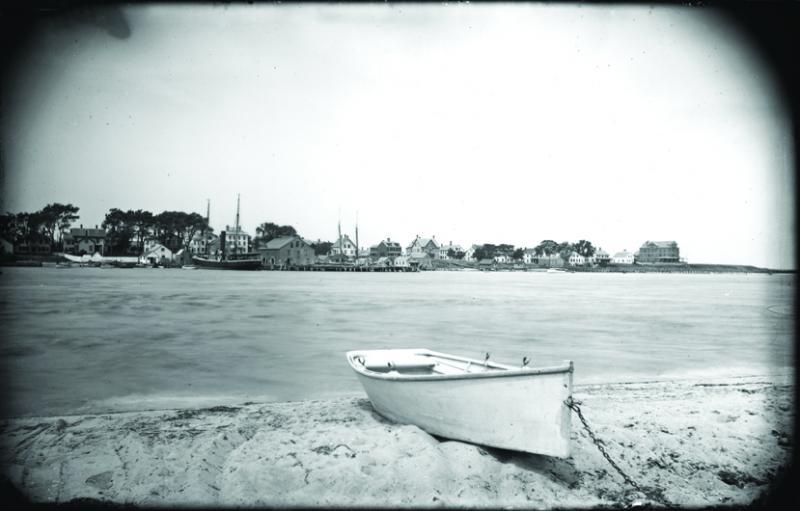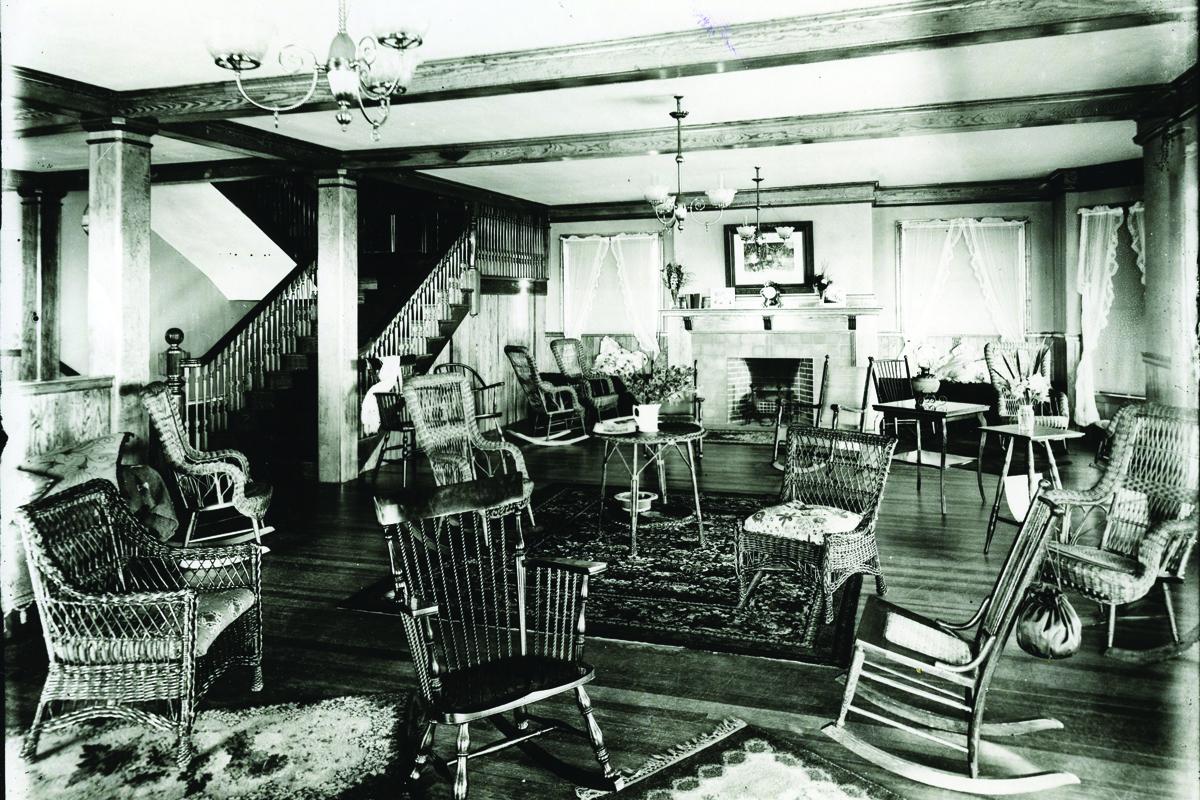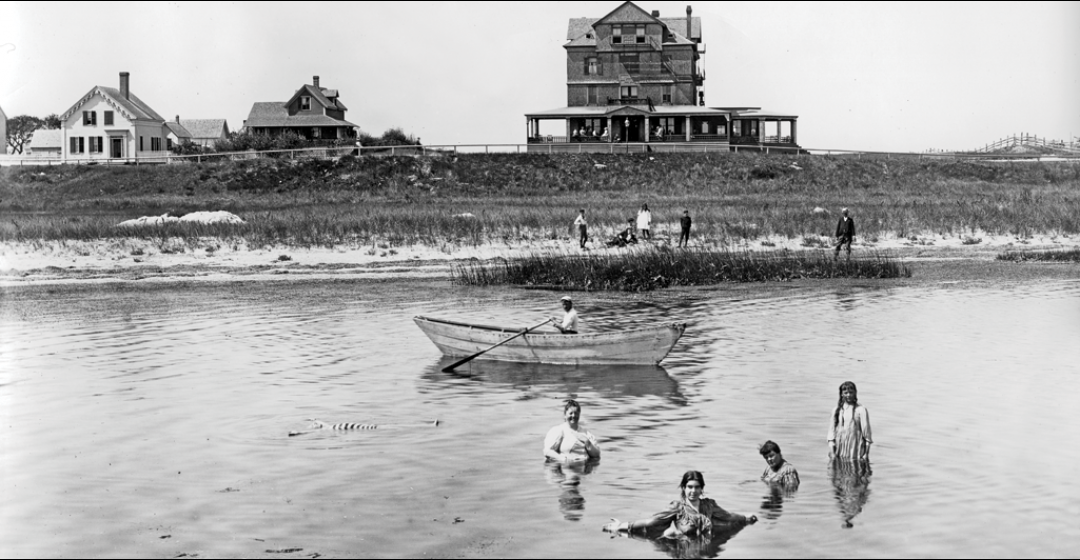On the morning of Wednesday, July 1, 1891 a large flag with a white background, blue border, and the words “Harbor View” in crimson letters was run up the flagpole of a new enterprise at the very edge of Edgartown. Inside, at a handsome wood counter, manager J. V. Drew welcomed the hotel’s first guests, Mr. and Mrs. George B. Elliott of Boston. For a daily rate of $2.50 or $3.50, they were promised three meals a day and a room with the latest in comforts and conveniences, including gas lighting, mattresses of horsehair and woven wire springs, and baths and toilets on each of the three floors. Other than the price of the room and the period accoutrements, it might today seem an unremarkable thing. But in the summer of 1891, the welcoming and housing of guests at a resort hotel was an event Edgartown had been awaiting for decades.
Once home to the wealthiest whaling captains on Martha’s Vineyard, Edgartown had struggled with a declining economy for decades, since the mid-century collapse of the whaling industry. A few Edgartown businessmen were prospering by investing in the booming resort neighborhood known as Cottage City on the outskirts of town, which seceded in 1880 and was later renamed Oak Bluffs. There, what had begun in 1835 as a religious retreat under the oaks in a sheep field had led to the development of a new seaside resort that boasted small residential lots, curved avenues, and hotels for the visitors. A substantial new wharf made it ever easier to get to Cottage City, and by the 1870s there were hair dressing parlors, bakeries, milliners, tailors, photographer studios, and more. With thousands of summer visitors, it was a developer’s dream.
But the same was not true in Edgartown proper, where an editorial in the Vineyard Gazette in 1864 described a shocking street scene outside its offices of “hideous yells” emanating from “a score or more men in pursuit of a half dozen filthy, dirty, ragged women who are a disgrace to their sex and to humanity.” The town’s population plummeted by nearly half in just four decades, to a low of 1,156 in the 1890 census. “In a commercial sense it is a place far advanced in decay,” wrote Harvard professor Nathaniel Shaler in an 1874 travel piece in the Atlantic Monthly. “Of all its whaleships, which got from the sea the hard-earned fortune of its people, there is but one left. This lies upon the ways, stripped of its rigging, a mere effigy of a living craft...little by little the population is drifting away; some houses stand empty, and the quick agents of decay which make havoc with our frail New England houses will soon be at work at them, and even Yankee thrift cannot keep it away.”
Edgartown had tried once before to reinvent itself as a summer resort, but the first effort met with little success. In 1872, Dr. Daniel Fisher, whose whaling fleet made him the wealthiest man in Edgartown and whose 1840 mansion is a landmark on Main Street today, invested more than $2,000 to help extend the Vineyard Sound Railroad from Boston to Woods Hole. That same year the citizens of Edgartown voted to lay a beach road from the bustling resort at Cottage City. Two years later the taxpayers voted to spend $15,000 to build a railroad from Oak Bluffs to Edgartown.

The idea behind the railroad was that at its Edgartown terminus, on the Katama plains south of the village, the success of Oak Bluffs could be duplicated with a grand summer lodge called the Mattakeset, and a development of cottages around it. The director of the Oak Bluffs Land and Wharf Company, E. P. Carpenter, was enlisted as chairman of the project, and the longed-for village of summer cottages was gridded out by Boston landscape artist Robert M. Copeland, the designer of Cottage City.
It was clear almost from the beginning, however, that the Mattakeset would not be Edgartown’s tipping point as a summer resort. The lodge, with 75 guest rooms and 125 feet of frontage on Katama Bay, opened in August 1873. Just a few weeks later the Panic of 1873 caused banks to collapse all over the country, sending the nation plunging into recession. As a result, only a few speculators bought lots and no new city of cottages sprouted on the plain. The Edgartown railway line, built on the sands along the new beach road and damaged each winter by northeast storms, ran its last train to Katama in 1895. The Mattakeset lodge hung on for a few years, but closed for good in the fall of 1905.
The Mattakeset had been an expensive lesson but an important one: Edgartown would not find its success as a resort by imitating Cottage City. But perhaps it could succeed by recognizing and building on its own best asset, the historic town itself. With that in mind, sixteen local men pooled their funds and proposed to build a resort hotel that they hoped would steal the visitors from the hotels of Cottage City and deposit them in downtown Edgartown. They formed the Edgartown Hotel Company in August 1890, and capitalized it with $5,000 – fifty shares of stock with par value of $100 each.
Announcing the news, the Vineyard Gazette hailed the list of investors as “indeed a roll of honor,” declaring, “The gentlemen who have displayed the public spirit and business sagacity, in at last taking hold of this hotel matter, are entitled to and will receive the approbation and good wishes of the entire community.”
Through the winter of 1890 and into 1891 the people of Edgartown eagerly followed construction of the hotel, and not just because winters were even quieter on the Island a century ago than they are today. In November, the Gazette launched a competition asking the public to send it suitable names for the new hotel. The prize was to be a copy of Webster’s International Dictionary, just published by G. & C. Merriam & Co., Springfield, Massachusetts, which retailed for $12 and was described by the newspaper as “by far the most elegant unabridged Dictionary ever published.”
Six hundred votes poured in by mid-December, with “Hotel Edgartown” taking a commanding early lead. “Harbor View” at first was a distant sixth, among such colorful contenders as Hotel Mizpah, Hotel Nashaquitsa, Hotel Nunpaug, Hotel Quinomica, The Montezuma, the Swasey, and even a deliberate misspelling, Hotel Edgarton.

Then came a stream of letters to the editor. Correspondents protested that some ballot stuffers cared more about winning the dictionary than giving Edgartown’s new landmark a fitting name. These sentiments resonated in town. By the end of January, “Harbor View” had inched into the lead with 114 votes, “Hotel Edgartown” close behind with 100. When the voting closed in February with more than 800 ballots cast, “Harbor View” was the winner, and L. C. Bliss of Cambridge was awarded the dictionary.
While the great name debate raged, close attention was also paid to the building itself, which was partially framed by December of 1890. “Masons are busy on the chimneys, and the work of digging the cellar under the rear extension has begun. With weather like that of the past three days the building will ‘grow’ very perceptibly during the coming week,” the Gazette reported. Even the shingles were newsworthy. “The shingles which are to be used on the new hotel are as handsome a lot as have been seen in town for a long time. They are originally from St. John, N.B. It is calculated that 100,000 will be used on the hotel building.”
By April the plastering was finished, and a crew from the firm of Hobart & Butler set to finishing the carpentry work. Local workmen followed the carpenters with their brushes and buckets of paint. In May, J. V. Drew of Boston was announced as the Harbor View’s first manager, in part because he had managed the Hotel Naumkeag at Cottage City the season before. The new hotel was furnished in June and readied for its inaugural 1891 season.
“The hotel, naturally, in the last two weeks has been visited by hundreds of our townspeople who are interested and curious as to all the details of furnishings, etc.,” reported the Gazette that July. “In every instance these visitors have been met with that quiet cordiality and courtesy which are characteristics of the model landlord and which will be appreciated the coming summer by the hundreds of guests who will find a home at the Harbor View,” it added hopefully.
When the official grand opening of the Harbor View hotel took place a few weeks after Mr. and Mrs. Elliott were greeted as those first guests in 1891, hundreds of people from across the Island and the mainland attended. By the light of Chinese lanterns hung along the hotel’s long piazzas, they danced into the night. It was, according to the Gazette, an event filled with “princely hospitality.”
It would still take much longer than anyone expected for the new summer economy to fully take hold and lift the fortunes of both the new hotel and old town. In particular, the first dozen years of the Harbor View were like a sea voyage – sometimes smooth, sometimes rough, always interesting.
But for that one night, at least, the whiff of success – both future and past – was in the Edgartown air.





